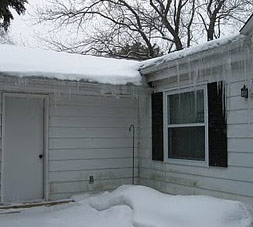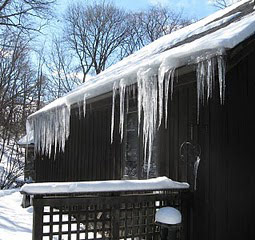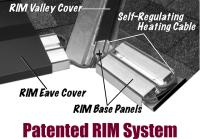Ice Dam Causes
Very simply - snow and heat. Ice dams are formed when snow melt refreezes at the eaves (gutters) and in the valleys. Causes for snow melt can be heat loss from the house, solar radiation (sun's rays) and temperature fluctuations above and below freezing. The cycles of melting and freezing cause a build up or DAM. This dam traps water behind it. The trapped water builds until it finds a way into the house. Also associated are icicle formations. Some of the dammed water flows over the top of the dam and refreezes as icicles.
Ice dams are not caused by gutters or gutter protection. Some gutter protection tends to display the ice dam sooner. Reverse curve or 'helmet' style gutter toppers are fabricated from thin metal which cool very quickly. Their placement above the gutter means you see the ice forming earlier. Some attempts have been made to heat these covers, usually with little success. The metal is just too thin to be a good conductor of heat.
 Ice dams cause property damage and can pose a risk to people as well. Falling icicles (ice weighs @ 60 lbs. per cubic foot) can hit people, cars, lower structures, etc. Leaking water damages drywall, lowers the effectiveness of insulation (making the problem worse), and can lead to rot and mold growth. Repeated ice dam cycles weaken roof structures, loosen gutters, damage shingles, and cause a variety of other problems.
Ice dams cause property damage and can pose a risk to people as well. Falling icicles (ice weighs @ 60 lbs. per cubic foot) can hit people, cars, lower structures, etc. Leaking water damages drywall, lowers the effectiveness of insulation (making the problem worse), and can lead to rot and mold growth. Repeated ice dam cycles weaken roof structures, loosen gutters, damage shingles, and cause a variety of other problems.
Air Sealing. This is the practice of restricting the movement of air from the heated living space into the unheated attic space - whether open or cathedral. This entails the use of vapor barriers on the heated side and sealing all penetrations and holes leading to the attic space - including plumbing vents, exhaust vents and can lights. This is the most important aspect of minimizing ice dam formation. This is a must on all new construction and should be performed as permitted on existing homes.
 Insulation. Installing or adding the proper amount of insulation for your area. In the upper midwest it is recommended to have R49. Other areas require different amount. Local building codes should dictate. Insulation provides a moderating of temperatures between two areas. Without proper air sealing additional insulation may not provide much relief from ice dams.
Insulation. Installing or adding the proper amount of insulation for your area. In the upper midwest it is recommended to have R49. Other areas require different amount. Local building codes should dictate. Insulation provides a moderating of temperatures between two areas. Without proper air sealing additional insulation may not provide much relief from ice dams.
Ventilation. Proper ventilation is balanced ventilation. Intake at the eaves is balanced with exhaust at the ridges or upper peaks of a roof. Ventilation additions or improvements need to be done in conjunction with air sealing and insulation improvements. Modest temperature differences between attic and outside air means that passive ventilation (roof and eave vents) moves very little air. The idea is that 'drafting' occurs. The colder air at the soffit/eaves pushes the warmer air out through the ridge. In order for this to work, it requires larger temperature differences than are usually present in the winter. The meager amount of air movement cannot keep up with unchecked heat loss. To make matters worse, some have turned to the use of power ventilation with humidistats. The idea is that as the humidity level builds in the attic, these fans will turn on and expel the hot, moist air. However, often the aggressive pulling of air through these fan vents draws warmed air from the living space - compounding the problem.
The issues are complex. For sure, a competent contractor or home performance analyst is needed. With the complex design of houses and current and past building practices, solving ice dam problems can be difficult. Doing it right can cost tens of thousands of dollars. Short cutting may result in lack luster results or worse - a sick house. All that can be done on the inside - air sealing, insulation, ventilation - may not prevent ice dams from forming and causing problems. Temperature fluctuations, the insulating effect of snow and solar radiation can and do lead to ice dam formations.
 Roof and Gutter Ice Melt Systems. When analyzing an ice dam problem one should consider a roof and gutter ice melt system. Bylin Engineered Systems has a patented system that is effective at preventing ice dams from forming. The system is called the RIM (Roof Ice Melt) System. It uses self regulating heat cables to heat aluminum panels. These panels evenly and effectively transfer the heat to the surrounding area, minimizing the chance that and ice dam can form. They have configurations that work at the roof's eave and in the valleys. The gutters and downspouts are also heat traced with the self regulating heat cables. To view this system and other applications please visit Wisconsin Ice Dam Solutions.
Roof and Gutter Ice Melt Systems. When analyzing an ice dam problem one should consider a roof and gutter ice melt system. Bylin Engineered Systems has a patented system that is effective at preventing ice dams from forming. The system is called the RIM (Roof Ice Melt) System. It uses self regulating heat cables to heat aluminum panels. These panels evenly and effectively transfer the heat to the surrounding area, minimizing the chance that and ice dam can form. They have configurations that work at the roof's eave and in the valleys. The gutters and downspouts are also heat traced with the self regulating heat cables. To view this system and other applications please visit Wisconsin Ice Dam Solutions.
Monday, January 31, 2011 3:02:00 PM